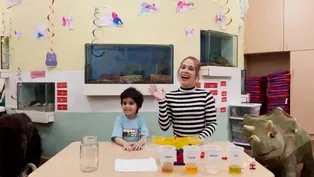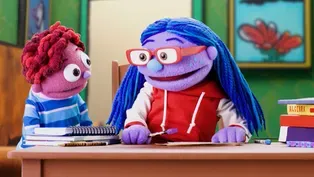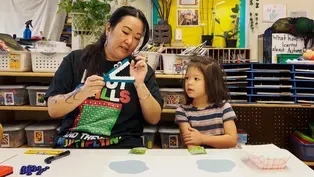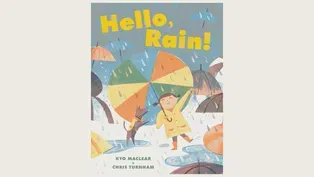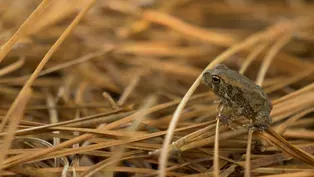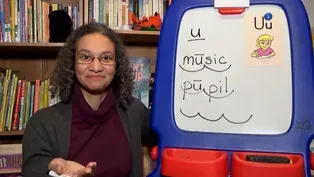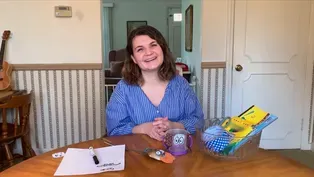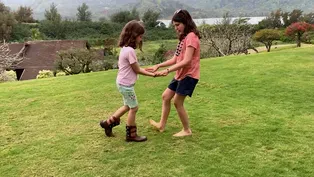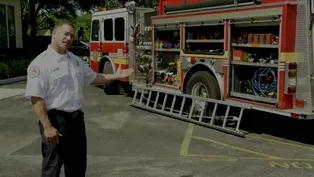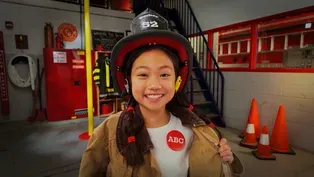
DO YOU HEAR THE LONG “U” IN UNICORN?
7/18/2024 | 57m 47sVideo has Audio Description, Closed Captions
LET'S LEARN about water! Read HELLO, RAIN! Compare the density of water to other liquids.
LET'S LEARN about water! Read HELLO, RAIN! Compare the density of water to other liquids. Meet a firefighter and a toad. Solve “The Case of the Cake Commotion.” Make puppets. One-hour programs help children ages 4-7 learn while having fun. Content provided by Brooklyn Preschool of Science, Dancing Classrooms, Feel Your Best Self, Flor Bromley, Houston Zoo, New Victory, Meet the Helpers.
See all videos with Audio DescriptionADProblems with Closed Captions? Closed Captioning Feedback
Problems with Closed Captions? Closed Captioning Feedback
Let's Learn is a local public television program presented by THIRTEEN PBS

DO YOU HEAR THE LONG “U” IN UNICORN?
7/18/2024 | 57m 47sVideo has Audio Description, Closed Captions
LET'S LEARN about water! Read HELLO, RAIN! Compare the density of water to other liquids. Meet a firefighter and a toad. Solve “The Case of the Cake Commotion.” Make puppets. One-hour programs help children ages 4-7 learn while having fun. Content provided by Brooklyn Preschool of Science, Dancing Classrooms, Feel Your Best Self, Flor Bromley, Houston Zoo, New Victory, Meet the Helpers.
See all videos with Audio DescriptionADProblems with Closed Captions? Closed Captioning Feedback
How to Watch Let's Learn
Let's Learn is available to stream on pbs.org and the free PBS App, available on iPhone, Apple TV, Android TV, Android smartphones, Amazon Fire TV, Amazon Fire Tablet, Roku, Samsung Smart TV, and Vizio.
Providing Support for PBS.org
Learn Moreabout PBS online sponsorship- [Presenter] Ready to learn?
- And I have with me here my friend... - Malena!
- [Presenter] It's time to share a story, read and write.
- What's this word going to be?
- [Presenter] Discover science.
- Whoa!
- [Presenter] Sing.
♪ How you goin' clean up the earth ♪ ♪ If you don't clean your room ♪ - [Presenter] Play, and so much more.
- We solve... - [Both] Word mysteries!
- [Presenter] Stay tuned for lessons and activities.
[children giggling] [bright music] Funding for this program was provided by the JPB Foundation.
[bright music continues] - Did a word that's important to you go missing?
- And now all you can feel, do, or think is the opposite of that word?
- Then call us!
I'm Sly.
- And I'm Gabby.
We're word detectives and we solve... - [Both] Word mysteries!
- Together we run the Wordsville Online Detective Agency.
- We'll find your missing word fast.
- Not to matching briskly.
- And swiftly.
- Yeah, we're really good with words.
- [Children] Wordsville!
- And the winner of the staring contest is... Me!
Yay.
- You're usually more excited when you win, Gabby, like jumping around shouting, "I won, I won, I won!"
more.
- I know Sly, but I don't feel happy about my win.
Is it a word mystery?
- Could be.
Look, Baker Graham's calling.
- Word Detectives, someone's taken my special celebration cake.
See?
This is the worst thing that ever happened in the world.
- A celebration is a special happy event marking something important that has happened.
You can celebrate big things like birthdays or smaller things like winning a staring contest.
- And people like to celebrate special events with sweet treats.
- This is a word mystery.
Tell us what happened when the cake went missing, Baker Graham.
- And I'll animate it.
- [Baker Graham] I was at the bakery finishing the celebration cake.
People often put candles on cakes to celebrate special events, so I was planning to put a bunch on this one.
That's when Artist Clay came in and ordered a single cupcake.
Then Firefighter Ember arrived.
She said my celebration cake looked amazing, but Artist Clay suggested it would look better with cake sparklers.
I thought that was a sweet idea so I ran off to get some.
But when I got back, Firefighter Ember, Artist Clay, and the cake were gone.
- Can you show us the scene of the mystery?
- Sure.
The last place I saw my celebration cake was here on the counter.
- [Gabby] I don't see any clues.
What's the calendar for?
- [Baker Graham] To keep track of all the special days from Wordsville.
- I'll take a screenshot.
Don't worry, Baker Graham, soon we'll celebrate us solving this case.
- I sure hope so.
- [Sly] Case notes open.
What do we know?
- [Gabby] We know what happened.
Someone sold Baker Graham's celebration cake and now we can't celebrate anything in Wordsville.
We know where it happened, the bakery, and it happened when Baker Graham left to get cake sparklers.
- [Sly] Our suspects are Firefighter Ember and Artist Clay.
Now we need to figure out who did it, how and why.
Piece of cake.
- This case might not be that simple, but let's call our first suspect.
Are you okay?
Is this a bad time?
- The worst.
My favorite saying is ABC.
Always be celebrating.
- That's a great favorite saying.
Mine is play every day.
- Mine is let's focus on the case.
- Right.
I take pride in a job well done.
And acknowledging my achievements makes me feel good.
What better way to celebrate than with one of Baker Graham's cookies?
- Oh, I love his cookies.
- Let's focus on the case.
- That's a good favorite saying.
- I was about to ask Baker Graham for a cookie when he took off to get cake sparklers.
I didn't know how long he'd take so I left the bakery and came back here.
- Were you planning on celebrating anything special with that cookie?
- My hundredth washing of the Wordsville firetruck!
But I just don't feel like celebrating that anymore so I'm gonna go.
- Firefighter Ember wanted to celebrate a job well done, but Baker Graham left before she could get a cookie.
So did she celebrate with the big celebration cake instead?
- Hmm.
Let's see if Artist Clay can offer any new clues.
- Oh, hello Word Detectives.
- Artist Clay, were you at the bakery today?
Do you remember seeing Baker Graham's celebration cake?
- It was so big it was hard to miss.
But I suggested some cake sparklers to make it truly shine.
- Nice idea.
- Baker Graham thought so too.
When he went to get the cake sparklers, I took my cupcake and left.
- Wait, is that your cupcake?
Nice candle.
Are you celebrating something special?
- What?
No.
Today's a totally normal day with absolutely nothing to make a fuss about.
This has been a lot.
I need some quiet time now.
Goodbye.
- Hmm.
We should get back to the cake notes.
I mean case notes.
- [Gabby] Hmm, Firefighter Ember wants to celebrate her hundredth washing of her firetruck with a cookie, but Baker Graham left before she got it.
Maybe she took the celebration cake so she could celebrate.
- Maybe.
Artist Clay did get a treat from the bakery.
A cupcake.
He even put a candle on it.
Which is weird 'cause people put candles on things for special events.
But he said he had nothing to celebrate.
- Let's look at the scene of the mystery clues.
- Wait, look at today's date.
It says ACB.
It must stand for something.
- ABC stands for always be celebrating.
- Exactly!
But this is ACB.
- Apple cake batter?
Always cook biscuits?
Get us to take those treats?
- Those last words don't start with A C or B, Sly.
- I know, but I want Baker Graham to give us treats when we crack this case!
He can even put candles on them to make it extra special.
- That's it, Sly!
Today's a special day for one suspect.
- And ACB gives us a big clue who.
Gabby, it's time to show everyone how this word mystery happened.
Now presenting the word mystery animated re-enactment of The Case of the Cake Commotion.
- [Gabby] Enjoy your cupcake Artist Clay!
- [Sly] Hello Baker Graham.
Can I get- - [Gabby] A look at my celebration cake?
- Actually, I- - Think it would look better with sparklers on it?
- [Gabby] Great idea.
I'll get some, bye!
- [Sly] But my cookie!
I'll just leave.
I'll just leave with my cupcake and this.
- Artist Clay is who took the cake.
- Artist Clay!
- How could you possibly know that?
- Piece of cake.
The candle on your cupcake means you're celebrating something special.
- And the note on Baker Graham's calendar where he keeps track of special days told us what.
ACB.
- ACB means Artist Clay's birthday.
Today is your birthday, isn't it?
- Yes, it is.
- You took the celebration cake?
But why?
- I saw the note on your calendar and a celebration cake for lots of people.
I figured you were planning something big.
- I was, a huge surprise party.
- But I don't like big parties.
They're loud and overwhelming.
I'd rather people celebrate my art quietly and not make a fuss over me.
But I know now that without celebration, no one can celebrate anything.
I'm so sorry.
Taking the cake was wrong.
I'll return it.
- I'm so happy I have my cake back.
- What are you gonna do with that sweet cake?
- Well, Artist Clay, I know you don't like big birthday parties, but how about you, Firefighter Ember and I celebrate your birthday quietly?
- I'd be happy to celebrate that way.
- Me too.
ABC.
Always be celebrating.
- I'll bring you some cake later.
- [All] Thanks Word Detectives!
- Another word mystery solved.
We should celebrate.
- That reminds me, I never celebrated my staring contest win properly.
I won, I won, I won, I won, I won!
- Best two out of three?
- You're on.
[bright music] - Hello friends, how are you today?
My name is Anna and I was just about to read a story about my two favorite things.
The first thing is rain.
I love going out and playing in a rainstorm with my daughters.
The other thing is something called onomatopoeia.
Have you ever heard that word before?
Say it.
Say "onomatopoeia."
So what onomatopoeia is, it's basically words that represent sounds like crash, bang, bing, right?
Those are all really great words, they're onomatopoeia.
They represent a sound.
So the book we're gonna read today is called "Hello Rain!"
The book is Kyo Maclear and Chris Turnham.
Let's see if you can find some onomatopoeia in the book.
I wanna know which one's your favorite at the end.
"Hello Rain!"
by Kyo Maclear and Chris Turnham.
The air is full of waiting.
The sky is full of breeze.
The trees gust and billow all before it rains.
Rumble, rumble.
Distant thunder.
Rain is coming.
Rain is coming.
Could you actually hear that rumble?
Could you feel the rumble?
Plink, plunk, plunk on the rooftop.
Drip, drop.
Metal mailbox ping.
Every rainfall plays a different tune.
Listen, listen.
Rain, rain, rain.
Can you think of the sounds you hear when it rains?
Old raincoat, rubber boots, big umbrella, best umbrella.
Green, orange, yellow, blue.
Let's go outside.
On the streets, umbrellas bloom.
Around us, a game of hurry.
Dash, dart, skitter, scatter.
But why hurry when the sky is an adventure?
Deluge, downpour, sprinkle, storm.
A drizzle, a mizzle.
So many words for rain.
Long, thin threads.
Tiny parachutes, buckets at a time.
Out of many drops, one big puddle!
Curbside waterfall.
Downhill swoosh.
Out of many drops, one rushing river.
Let's launch the fleet.
Drippy leaf, slippy rock.
Here is an earthworm, a sticky snail.
Here is a seedling.
Even when it pours, the frogs don't hurry or hide.
Hyacinth, foxglove, poppy, yaro.
Down in the dirt, the thirsty roots are drinking.
Cool rain, fresh rain.
A barrel to catch the drops for later.
So we can have pink roses, frilly peonies, tangles of vines.
Bursting pea pods, bright carrots, leafy radishes.
Plums in the fridge.
Sweet and cold.
One for you, one for me.
In a quiet spot, a single drop of rain touches five times a branch, a leaf, an apple, a rock, a blade of grass before reaching the ground.
We crouch under a tree and whisper talk until crack, flash!
Inside.
Wet socks, drippy pants.
Shake, shake, shake of rain drenched fur.
Inside, dry and warm.
Rain trickle flows against the window.
Mini rivers, droplets joining, moving down, down, side to side.
Wanna play a board game?
Wanna read a book?
Wanna build a fort?
Naps and secrets are both better when it rains.
I wonder how the rain decides how and when to be.
I wonder how it decides when to plunk, plunk, flink.
Stop.
The ground is glistening green.
Can you smell the grassy sweetness?
Butterflies and bugs sip, sip, sip from muddy puddles.
Can you hear the chirping birds?
Hello sparrows with your bright sparrow voices.
Hello goldfinches, with your swee-swee song.
Hello flowers, ripe and rosy.
Hello mushrooms, plump and proud.
Hello sun!
Wasn't that an awesome story?
Did it make you think about all the things you like to do when it rains?
So if you had to pick what was your favorite word, your onomatopoeia word that you heard in the story.
I know which one mine was.
My absolute favorite one is the page where it went, "Crack!
Flash!"
I love it.
I actually felt like lightning and thunder was happening right now!
Oh my goodness.
Well, I hope you enjoyed listening to the story, "Hello Rain!"
with me.
I look forward to seeing you again next time.
Bye!
[bright music] What have you been up to today?
Oh, that sounds like fun.
Well, I have been stuck inside because it's raining where I live so I've spent most of the day just listening to music.
But that's actually kind of perfect because I wanted to review a sound today.
Do you wanna review that sound with me?
Great.
So I was going to review the long "U" sound, like you hear in the word music.
So today we're gonna review the long "U" sound.
U, pupil, U.
Can you say that?
Yeah!
So there are actually three ways that we're gonna focus on making that U sound.
So the first way is we're gonna actually use the letter U to represent that U sound.
Now there's something really specific and special about when U is making a sound.
It can't be closed in or covered by other letters.
So for example, if I put a word like this, right here, U is not gonna be able to say its name, right?
Right here it's gonna make it short sound.
So it's gonna say "uh," and that's not what I want.
So let's think about the word music.
I was telling you how I was listening to music today.
So watch as I write the word music.
Mu-sic.
Now, how many syllables are in music?
Can you clap that for me?
Right.
Mu-sic.
Notice how I hear that long U sound at the end of that first syllable.
Well, that's why we're able to put the letter U there because it's what we call an open syllable.
So this is why it says music, not musik.
Okay?
How about the word pupil?
So pupil like the pupil in your eye or in this case, pupil is a student like you.
So if I were gonna spell the word pupil, well, let's figure out those syllables again.
Pu-pil, so there's two.
So pu-pil.
So for the pu part, I'm gonna need p. And then U gets to say its name, pu.
And then I'm gonna add the ending 'cause I'm gonna give you that part.
So pu-pil.
Pupil.
All right, let's try one more.
This is actually my daughter's favorite word.
The word is unicorn.
How many of you like unicorns?
They're pretty cool.
All right, so when I think of the word unicorn.
U-ni-corn.
Okay, this one has u-ni-corn.
Okay, it has three syllables.
Now that first syllable is what sound?
Great, U.
So what do you think is representing the U sound in unicorn?
That's right, you're so smart.
The letter U.
Okay, I'm gonna give you the rest.
So u-ni-corn.
I love it.
Unicorn.
Okay, so that's one way we can make that U sound.
Now, another way we can make that U sound, and I'm gonna put the U here so we don't forget about it, is if we use E-W. Now what's special about this is when you hear U at the end of a word, one of the ways it'll be spelled is E-W.
So for example, if I said the word few, like I only have a few more snacks left.
Oh, bummer.
All right, so for few I would start with that f sound.
So f. And then the U sound is being created by E-W. Few.
Well, if you can spell few, you can spell pew.
So if you've ever been to church or sat on a long bench, sometimes they're called a pew.
So how would I turn few into pew?
F-ew, p-ew.
That's right, I need to change that initial sound.
So it's no longer going to be f, it's now going to be p. Well, what letter represents that p sound?
Oh yeah, thank you!
P. So p-ew.
Pew.
All right, let's do one more.
How would I turn pew into mew?
Like the sound a cat makes.
To mew.
So thinking, what's changing pew, mew.
That's right, it's that initial or first sound again.
So how would I turn p into m?
Awesome.
So the P would turn into M and then I would still add my ew.
Mew.
Let's read the three words together.
We have few, good.
Pew, mew.
Okay, I'm gonna add that second spelling of U over here.
Now let's do the last one.
You're doing such a great job.
Okay, the last way we're gonna talk about making that U sound is U-E. Now this also usually appears at the end of a word.
So a great example of this word I like to think of is rescue, like when someone tries to save you, rescue.
So watch how I spell rescue.
Res-cue.
Okay, so you see my U-E at the end of the word.
What about the word argue?
Okay, so I'm gonna give you the first part.
Ar-g. Now, how do you think that U is going to be spelled here?
That's right, U-E. Now I see some of you looking at me like, "Hey Anna, but how do I know which U to use at the end?"
Well, this comes with exposure.
That means the more you see these words and the more you read these words and the more you write these words, you're gonna figure out which correct spelling of U goes with which word.
But let's practice a little bit.
I have some words that are gonna appear on the screen and I want you practicing first reading the words and then for the second word, trying to figure out which U spelling would you use for the words.
Okay, good luck.
Remember, we are reading U, U-E, and E-W as the long U sound.
U.
Read the words on the screen.
Hopefully you said music, few, and argue.
Which spelling for the long U is needed to complete each word?
Pupil.
Mew.
Rescue.
Wonderful job, scholars.
You did an amazing job working with our three spellings of long U, U, E-W, and U-E.
Remember, the way you're really gonna master these words and the spellings is through practice.
So practice reading them and practice writing using them.
Well, until next time, friends, bye!
[bright music] - Today we're gonna talk about animal babies and how they're raised in the wild.
Whether it's a single parent or both, if the entire family helps out or if that baby animal is left to learn everything on its own, it's fascinating to see how animals are raised in their native habitat.
- [Narrator] An all by myself family type is based on instincts and is where the baby is left to figure out how to live on its own.
In many cases, these animals never meet their mom or dad.
This is very common in most fish, amphibians and reptiles.
It usually involves animals that lay a large number of eggs.
Some species will guard or care for their eggs prior to hatching, but not raise their young.
Most animals that do not have their parents around already know how to survive.
They're born with the skills to find food and avoid predators.
They're also born as miniature versions of adults, like baby lizards.
They're hatched from eggs and can immediately run to shelter and begin finding food.
Another great example is baby sea turtles.
Once they're born on a beach, they know how to swim out to sea and can swim as soon as they reach the water.
Houston toads are hatched from eggs and grow to be tadpoles, thin tiny toads.
They have to fend for themselves immediately after they're born.
Houston toad, such an amazing animal.
These guys were once found in lots of counties along the Texas Gulf Coast.
Today they're mostly found in central Texas in the areas of Bastrop County with a few populations in Austin County and Colorado and Leon Counties as well.
The Houston Zoo has a breeding facility for this endangered animal to help increase Houston toad populations in the wild.
In 2018, the zoo and its wildlife partners released nearly 1 million Houston toad eggs into Bastrop State Park.
That's about as much as filling NRG stadium where the Houston Texans play 13 times.
The hope is that a majority of those toad eggs will grow to be tadpoles and eventually adult toads to then produce baby toads on their own in the wild.
These are toads from the zoo's breeding program.
They all hatched in May of 2017.
They are quite happy with their five star digs at the Houston Zoo.
They even get crickets delivered by room service.
But in the wild, they prefer a sandy soil and pine forest, like those found in Bastrop State Park.
[bright music] - Hi, my name is Renata Townsend.
I'm a teaching artist at the New Victory Theater.
I specialize in devised theater and puppetry.
Today I'm gonna be teaching you how to make some tabletop puppets using household objects.
This is a metal spoon that I found.
I named him Spoonster.
This is a snack cup that I stole from my son named Snack Attack.
To build these puppets, you need a couple of things.
You need a marker or a writing utensil, something you can draw the eyes with.
You need a piece of paper, you need some tape.
This is the only tape that I could find.
It doesn't have to be blue and white polka dot duct tape.
Scotch tape would probably even be better.
You need a pair of scissors.
And then if you have some sort of construction paper or colored paper or even a magazine, you can add accessories to them.
You also need a object.
And really, the more random the object, the better.
So I have a tissue box that I'm going to be building this puppet out of.
So the first step is you're gonna to take your marker and you're gonna draw your eyes on the puppet.
Now the eyes are the window to the puppet's soul.
So thinking about what kind of personality you either want your puppet to have or the personality, you can draw a pair of eyes and then say, "Hmm, I wonder what kind of personality these eyes have?"
I already prepped some eyes.
So after you draw your eyes and cut them out, you're then going to put a little bit of tape on the back of your eyes and attach them somewhere on your puppet.
I'm gonna put my eyes there.
Now take a look at your puppet and think about what kind of personality.
I just laughed because it looks like this puppet has a very funny hairdo and that was unexpected.
So once you have your puppet, you're gonna clear the table.
My cat is running around.
I don't know if you can see him back there.
And you're going to start with an entrance.
You can do a slow entrance, or you could do a fast entrance.
Ooh!
Something like that.
Once you get onto the tabletop, you are going to take a breath.
Puppets to make them come to life, you need breath and focus, so that's what we're gonna be working on.
You're gonna breathe [exhales] and then you're gonna have your puppet, not you, but your puppet look around.
You might wanna make some sound with that as well.
Then you're gonna have your puppet move.
Figure out how you want your puppet to move.
And then you're gonna have your puppet exit.
Again, you could do a fast exit or a slow exit.
I'm gonna go faster.
And that's it.
So I want you to create all the objects in your house.
I want you to make them all into puppets and then you can make an amazing puppet show.
Have fun and thanks so much for watching.
Cat!
There's a cat!
Ah!
No, you can't grab me.
[Spoonster yelling] [bright music] [Nina sighs] - Hey Nina, what's up?
- Oh, hi Nico.
- Is everything okay?
- I guess so.
- Hmm.
Looks like something's bugging you, Nina.
- Oh, yeah.
I'm not feeling my best right now.
I'm feeling kind of heavy, like a ton of books in my backpack are weighing me down.
- Do you wanna talk about it?
- I don't know.
I don't wanna bother you.
- Bother me?
No way!
We're supposed to help each other when we don't feel our best.
You remember when my dog Alfie ran off and we couldn't find him for a while?
I was super sad and really scared.
I didn't wanna talk about those heavy feelings, but my dad told me we could feel it together.
It helped a lot.
So come on, Nina.
Don't keep those feelings locked inside.
Share those feelings far and wide, wide, wide.
[both laugh] - Okay.
My friend Otis is moving away.
Right now, we go to the same school and we play together a lot.
But when Otis moves away, what am I gonna do?
- I'm sorry, Nina.
That's really hard.
I don't know what I'd do if you or CJ moved away.
- Otis and I have so much fun together.
We play basketball every day at recess, but that won't happen anymore.
I'm gonna miss him a lot.
- It can be hard when things change.
But just because Otis is moving doesn't mean you can't still be friends.
- How does that work?
- You can write letters, send a text, maybe even visit each other.
- It's not the same!
- You're right, it's not the same.
It doesn't feel great.
But hey, just like you always tell me, it's okay to feel all your feelings.
- I am sad.
But even though Otis is moving, we'll still be friends.
- Yeah.
- Thanks, Nico.
Talking about it made those sad feelings a little lighter.
- That's awesome, Nina.
- I didn't think anyone could understand how sad I felt about Otis moving.
I felt all alone with my heavy feelings, but talking to Nico about it really helped.
I feel lighter, like all the heavy books are out of my backpack.
I like to help my friends, but I forget that I need help sometimes too.
- So next time you feel something so heavy and you can't hold it by yourself, find someone to feel it together with.
- Thank you for feeling it together with me, Nico.
- Anytime, Nina.
[upbeat music] [bright music] ["Let's Move It!"
By Flor Bromley] [lively music continues] ♪ Let's move it, let's move it ♪ ♪ Shake your body, shake your feet ♪ ♪ Let's move it, let's move it ♪ ♪ Shake your head and bend your knees ♪ ♪ We are going to shake our wrists ♪ ♪ Shake your arms, let's do a twist ♪ ♪ Dancing is more fun this way ♪ ♪ Enjoy a sunny day ♪ ♪ Let's move it ♪ ♪ Let's move our shoulders ♪ ♪ Lets shake our hips ♪ ♪ Move your arms up high now ♪ ♪ And jiggle your nose ♪ ♪ Together let's move our whole body ♪ ♪ Come on everybody and jump way up high ♪ ♪ Let's move it, let's move it ♪ ♪ Shake your body, shake your feet ♪ ♪ Let's move it, let's move it ♪ ♪ Shake your head and bend your knees ♪ ♪ We are going to shake our wrists ♪ ♪ Shake your arms, let's do a twist ♪ ♪ Dancing is more fun this way ♪ ♪ Enjoy a sunny day ♪ ♪ Let's move it ♪ [lively music continues] ♪ Let's move it, let's move it ♪ ♪ Shake your body, shake your feet ♪ ♪ Let's move it, let's move it ♪ ♪ Shake your head and bend your knees ♪ ♪ We are going to shake our wrists ♪ ♪ Shake your arms, let's do a twist ♪ ♪ Dancing is more fun this way ♪ ♪ Enjoy a sunny day ♪ ♪ Let's move it ♪ ♪ Let's move our elbows ♪ ♪ Move around your torso ♪ ♪ Every little finger ♪ ♪ Stick out your tongue ♪ ♪ Now we will move our whole body ♪ ♪ Come on everybody, get up on your feet ♪ ♪ Shake it up and down ♪ ♪ Turn around, turn around, turn around, turn around ♪ ♪ Turn around, turn around ♪ ♪ Whoo ♪ ♪ Let's move it, let's move it ♪ ♪ Shake your body, shake your feet ♪ ♪ Let's move it, let's move it ♪ ♪ Shake your head and bend your knees ♪ ♪ We are going to shake our wrists ♪ ♪ Shake your arms, let's do a twist ♪ ♪ Dancing is more fun this way ♪ ♪ Enjoy a sunny day ♪ ♪ Let's move it ♪ ♪ Whoo ♪ [bright music] - Hi, I'm Maya, and today I'm going to be teaching you the heel toe polka.
First you start to tap your feet like heel, toe, heel, toe, and then shuffle back to back for me.
Heel, toe, heel, toe, shuffle back to back.
This part has hands like in hand clapping.
Clap your thighs, clap your hands.
Right, right, right.
Left, left, left and one, two, three, four, say goodbye to your old partner and hello to your new one.
And now Judy here is going to show you.
Look, you have what it looks like all finished.
[lively music] [lively music continues] And that's the heel toe polka.
[bright music] - Hi everyone.
Welcome to my classroom.
I'm Miss Zoe and today we have a great math game.
Today we are going to learn how to tell and how to show numbers that are greater or less than or equal to another.
And when we write it, we show it using symbols.
And a lot of times when we start learning in kindergarten, we have our little, we call him Gator.
And Gator loves to eat more of something.
So here's his mouth.
And so when his mouth is pointing at something, it means there's more of that, right?
So if there was a number here and a number here, Gator would want to eat more so he would take that number.
So we also have our equal sign.
This is a fun little equal sign, meaning two numbers are the same, have the same amount.
So here we have our mat with two ponds because gators, as we know, love the water.
And we are going to use these little blue stones representing water drops.
And so what we are going to do is we are gonna put a number of raindrops on one side.
And then my friend Anya, who will be here, will put raindrops on another side over here.
So now here we have five on one side and two on the other side.
We have two and five and five is more.
So like we said, Gator wants to eat the most.
So Gator would be positioned like this.
And we say two is less than five.
Now let's say a five is over here and the two was over here.
Gator would be facing a different way.
His mouth, because he wants more, would face this way.
I have one more example before we start the game.
So we have seven on one side, seven on the other side.
Is seven greater than, less than, or equal to seven?
It is the same so it is equal to.
So we put an equal sign.
And I would write it.
Seven is equal to seven.
Seven is equal to seven.
It is the same number.
Guess who's with me?
- Anya.
- Anya.
And Anya, today we are going to play a game called greater than, less than or equal to, meaning more, less, or the same.
Okay, so these are our raindrops.
Here are our ponds.
This is Gator.
And Gator loves to eat the most, right?
So if Gator's mouth is pointing to your pond, it means you have more.
If Gator's mouth is pointing to my pond, it means I have more.
So what we're gonna do is we're gonna pick a card.
Ready?
You pick your card.
These are my cards.
These are your cards.
Pick a card.
Okay, flip it over.
And what number did you get?
- One.
- One.
We got one and I got nine.
One, two, three, four, five, six, seven, eight, nine.
So you're going to put how many water drops on yours?
- One.
- One.
Go ahead.
One.
And I'm going to put nine.
One, two, three, four, five, six, seven, eight, nine.
So Anya, who has more?
- You.
- Me?
You're right.
So if we look at our two groups, one is less than nine.
So Gator is going to point and eat my pile.
And the way we write this, one is less than nine.
Like we said, Gator wants to eat the most.
All right, let's clear the board.
I wonder what she's gonna pick next.
What number is that?
- Six.
- All right.
Can you show our friends at home?
Six.
And I picked... - Two.
- Two.
All right, let's put 'em down.
- Ready.
- Go ahead.
- One, two, three, four, five, six.
- Great and I'm going to put two.
One, two.
So is six greater than two?
It has more.
So which way is Gator gonna face?
- My way.
- All right, go ahead.
Put Gator down.
Great job.
So we say six is greater than two, right?
And we write it.
Six is greater than two.
Okay Anya, your turn.
- Five.
- Five.
And I'm going to pick, can you show our friends five?
- Five.
- And I picked- - Five.
- [gasps] Five!
All right, you put yours down.
- One, two, three, four, five.
- All right, I'm going to count out the same.
One, two, three, four.
One, two, three, four, five.
So is five greater than, less than, or equal to?
Is it more, less, or the same?
- The same.
- It's the same.
So we say equal to.
So here's our equal sign.
Five is equal to five.
- But what's five plus five?
10!
- It's 10, but today we're working on greater than, less than and equal to.
So five is equal to five.
It is the same.
Alright, friends, let's say goodbye to our friends.
- Bye.
- Thanks for playing.
[bright music] - Hi, my name is Lieutenant Green and I'm a helper.
I'm very proud of my job because I keep you safe from fires.
I'm a firefighter.
You might see me if there's a fire in your neighborhood, if you're in an accident, or if there's been a bad storm.
I'm gonna tell you a little more about how firefighters help.
When I go to work, I wear a special uniform so you know I'm there to help.
During a fire, firefighters wear a special mask and suit and carry equipment to keep us safe from the heat and smoke.
My suit looks like this.
My jacket protects me from heat of the fire.
It's made with special fabrics that protect my skin.
A mask can help me breathe even when there's smoke in the air.
The mask filters out the dangerous smoke and my air tank provides fresh air to breathe.
I'm gonna show you what my mask looks like.
I might sound different.
It might look a little scary when I wear my mask, but don't be afraid if you hear my loud breathing or if you can't see my face.
I'm here to help you and my mask is here to help me.
My helmet and my visor protect my head and my eyes.
Another really important tool is my fire engine.
Fire engines carry firefighters and lots of tools to burning buildings so they're very big.
They're usually bright red in color and they have lights and sirens so you can hear and see me coming.
Let's go check it out.
This is my fire engine.
It's a little bit different than the cars grownups drive because it has a bunch of special tools so I can help you.
One of the most important tools on the fire engine is the fire hose.
It's connected to a big tank of water and it allows me to spray a bunch of water on a fire really, really fast.
Another important tool is a ladder.
The ladder allows me to reach high windows and really tall buildings just in case we need to save somebody.
I also have lots of other tools on the fire engine.
They help me out in many different situations.
[gentle bright music] One tool that can help you is a fire safety plan.
You can work with the grownups in your life to create a plan in case there's a fire in your home.
Talk about how you'll get out of the house if there's a fire and where you'll meet outside.
You can talk about fire safety and how important it is to never play with matches or fire.
In an emergency, you can help me by following instructions and never going back into a building that is on fire.
If a family member or pet is inside, you can tell me and I'll go to help.
I like my job because I get to help people like you.
If you see me in your neighborhood, wave hi, I like to wave back.
Firefighters like me are important helpers in everyone's neighborhood.
So what's my job?
To keep you safe.
And what's your job?
To be safe.
[bright music] - Hi everyone.
Crystal and Sahil here.
How you doing today, Sahil?
- Good.
- Awesome.
I hope my friends at home are doing good today.
We have four different liquids here.
And we want to test these liquids.
We want to see which liquid is high in density, which liquid is low in density.
We have one cup that is filled with honey.
- Honey!
- Honey.
- H for honey.
- H for honey.
I have another cup that is filled with corn syrup.
- Corn.
- Yeah, that's right.
You're right.
It does say syrup.
This is corn syrup.
- Corn syrup.
- Yes.
The third cup is filled with- - Water!
- Water.
Good job.
Yes.
And the fourth cup is filled with oil.
- Oil.
- Yes.
- Each cup, there's a different type of liquid, but they all have the same volume.
Volume means quantity or amount.
So it's all the same amounts of liquid.
Each cup has about 100 milliliters of liquid.
So what we're going to do, we're gonna use this balance here, this gram balance and we are going to see which liquid is high in density.
- Like heavier or- - That's right.
Which one weighs more?
- Like which one is heavier?
- Good job.
So first what we're going to do is test the honey.
- Honey.
- We're gonna place the honey.
- Corn honey.
- Well, this is the corn syrup.
So we're gonna test the honey and the corn syrup.
We're gonna place them right here.
Now, if the side that goes down, the side that goes like this, that means it weighs more so it will tilt down, okay?
That means that it has a high density.
- High density.
- Right, so now we're just gonna make sure it's balanced.
And now I'm going to carefully place this cup of corn syrup, this side like this.
And Sahil, I'm gonna ask you to place this cup on this side, okay?
But before we do it, let's make a prediction.
A really smart guess.
Which liquid do you think has a high density?
Do you think it's the honey or the corn syrup?
- Do you think it's the honey?
- Well, this is the honey and this is the syrup.
Which one do you think has a high density?
Which one weighs more?
- I think the- - The syrup?
- Syrup.
- Okay.
It's a good prediction.
Can you please carefully take the cup that has the honey and place it right inside there just like that?
Take your time.
Let's see what hap- Whoa.
The syrup, the corn syrup, has a high density.
- Corn syrup.
- Yeah, your prediction was correct.
Gimme five.
Good job.
Okay, so now we're gonna take them.
Whoop.
Alright, so now we're gonna place that here.
And now we are going to take the syrup and water.
- Water.
- Now, Sahil, prediction.
What do you think?
Which one has a high density?
Do you think the water has a high density or the syrup?
- The syrup.
- You think the syrup?
Okay.
That's a really good prediction.
Do you wanna try?
- Yes.
- Okay so first, what would you like to place in?
Would you like to place the water or the corn syrup?
- Water.
- The water?
Okay.
So you can place the water on that side very carefully.
Good job.
And now would you like to place the corn syrup on the other side?
- Yeah.
- All right.
Let's see.
Which weighs more.
Whoa!
- Whoa!
- High density.
Low density.
- Low density!
- Gimme five, your prediction was correct.
Ow!
Don't hurt my hand!
[laughs] Okay, good job.
And now what we're going to do is we are going to test, let's see.
Ooh, let's weigh the corn syrup and the oil.
Now, so the corn syrup has a high density when we compared it to the honey, when we compared it to the water, and now we're going to compare it to the oil.
Now let's make another prediction.
Which do you think has the high density?
Do you think it's the corn syrup or the oil?
- The corn syrup.
- The corn syrup?
Okay.
Which would you like to place into the gram balance?
- That one.
- The corn syrup?
Okay, you can place that one in.
Be careful in taking your time.
Good job.
Whoa, that is heavy, right?
That's very heavy.
Very dense.
Okay, now let's carefully place the oil.
Whoa!
Winner winner chicken dinner.
This guy's dense, right?
- Yeah.
- High density- - High density!
- Low density.
So you know what?
Now we're gonna take the syrup out because the syrup is very high density.
But you know what?
Let's try the other liquids, okay?
Let's see.
We'll leave the oil in there.
Let's test now the honey.
Do you think that the honey has a high density or the oil?
- Maybe the oil.
- The oil?
Okay.
Let's try.
Let's see.
Whoa.
Honey.
High density, low density.
Okay, good job.
We'll take this one out.
And now do you wanna try the water?
- Yeah.
- Water versus oil.
Let's see.
- Let's see.
Wow!
- Oh wow, look.
Hmm.
That's interesting.
The water's actually high density.
That's interesting, right?
- Yeah.
- Okay, scientist, so now what we're gonna do is, the fun isn't over just yet.
We're gonna put our gram balance to the side and we have this clear container here.
What we're going to do now is we are gonna pour these liquids into this cup.
And the liquid that is high in density, that weighs more, that is heavy, it's gonna go straight to the bottom.
It's going to sink.
The liquid that is light, it has a low density, it's going to float.
- Float in the water.
- Well, in all the liquids 'cause there's water, there's oil, there's corn syrup, and honey.
So I need your help, Sahil, can you please very carefully, we're gonna take the cup of the liquid and pour it inside that glass cup right there.
Water.
Check.
Okay, next.
Oil.
- Oil.
- Good job.
And what's next?
Honey.
- Honey.
- Ooh so thick, so dense.
It's so heavy.
Good job.
And now the final liquid.
- [Both] Corn syrup.
- There you go.
Pour that in there.
You're doing a great job, you're taking your time.
Good job, good job.
Now friends at home when you're doing this, please give the liquid some time to settle so that they can separate.
And then you can see the liquids floating on top of liquids.
Good job, Sahil.
And now we also created an awesome density column.
- Yeah.
- See?
And then if you look very carefully, you can see the liquid swimming.
You see the honey, the corn syrup.
Look at the water.
Yeah, you see the oil.
- Yeah.
- Gimme five, Sahil.
You are awesome.
- The oil's right there.
- Yeah.
Can you please say, "Science rocks"?
- Science rocks!
- Bye friends.
See you soon.
[bright music] - My name is Doris.
My husband David and I, we have two children, Dalia and Daniel.
Okay, go for it.
Our hope for our children is that they are happy, confident, and caring so that they can thrive in school and in life.
When I became a mother, it was very important for my children to be able to name and express their feelings so that they can better deal with their emotions.
Remember these?
When my children were very young, we started using picture books as tools to identify emotions within characters.
Sometimes I'll ask them questions to help them begin to identify their feelings for themselves.
I see a sad face.
Is that right?
If they can connect to their own feelings, then they can connect to others' feelings.
We make time daily to ask questions and practice listening.
- How was your day, Daddy?
- Oh, my day was amazing, Daniel.
- [Doris] And I think it just really shows them how to be a good friend and the importance of thinking of others.
- Congratulations Dalia.
- [Doris] Tapping into feelings has helped my children with confidence and self-awareness.
At school, they know how to manage feelings as they come up so that they can focus on learning.
- Alright, so have a good day in school.
Okay?
- [Presenter] Funding for this program was provided by the JPB Foundation.
[bright music] [bright music continues] [bright music continues] [bright music continues] [bright music continues] [bright chime] [no audio]
Video has Audio Description, Closed Captions
Clip: 7/18/2024 | 8m 18s | Compare the density of water to that of different liquids. (8m 18s)
FEEL YOUR BEST SELF: FEEL IT TOGETHER
Video has Audio Description, Closed Captions
Clip: 7/18/2024 | 3m 54s | Learn a strategy called “Feel it Together” to share sad feelings with supportive friends. (3m 54s)
Video has Audio Description, Closed Captions
Clip: 7/18/2024 | 8m 10s | Zoe Kleinmann plays a math game with a “gator” to learn about less than/greater than. (8m 10s)
Video has Audio Description, Closed Captions
Clip: 7/18/2024 | 6m 19s | Anna Scretching-Cole reads HELLO, RAIN! by Kyo Maclear. (6m 19s)
Video has Audio Description, Closed Captions
Clip: 7/18/2024 | 6m 19s | Anna Scretching-Cole reads HELLO, RAIN! by Kyo Maclear. (6m 19s)
Video has Audio Description, Closed Captions
Clip: 7/18/2024 | 2m 43s | Meet Houston toads hatched from eggs that transformed into tadpoles and then tiny toads. (2m 43s)
Video has Audio Description, Closed Captions
Clip: 7/18/2024 | 2m 21s | Sing “Let’s Move It!” with Flor Bromley. (2m 21s)
Video has Audio Description, Closed Captions
Clip: 7/18/2024 | 8m 3s | Learn different ways to spell words with the long "u" sound with Anna Scretching-Cole. (8m 3s)
Video has Audio Description, Closed Captions
Clip: 7/18/2024 | 3m 33s | Make tabletop puppets using household objects with Renata Townsend from New Victory. (3m 33s)
MAYANA TEACHES THE HEEL-TOE POLKA
Video has Audio Description, Closed Captions
Clip: 7/18/2024 | 1m 1s | Mayana from Dancing Classrooms teaches the heel-toe polka. (1m 1s)
Video has Audio Description, Closed Captions
Clip: 7/18/2024 | 2m 52s | Meet a firefighter! Learn about the ways firefighters are helpers. (2m 52s)
WORDSVILLE: THE CASE OF THE CAKE COMMOTION
Video has Audio Description, Closed Captions
Clip: 7/18/2024 | 7m 27s | Baker Graham's "celebration" cake has gone missing! (7m 27s)
Providing Support for PBS.org
Learn Moreabout PBS online sponsorshipSupport for PBS provided by:
Let's Learn is a local public television program presented by THIRTEEN PBS
